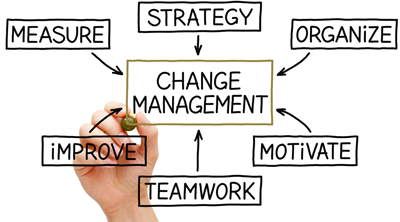The only thing sure in life is change. This rings truer than ever today. Our world is undergoing rapid societal and technological shifts. New markets are opening up with a whole new set of consumers. Many of the biggest companies today, barely existed 10 years ago. New, and old, players thoroughly disrupt traditional industries. No wonder that change management has become so important.
However, a 2013 survey by Strategy and the Katzenbach Center among global senior executives, found that the success rate for large change initiatives is only 54 percent. That’s barely half. It signifies a massive loss of resources. Both financial and emotional. A failed change effort will affect not only your finances but also company morale and make your employees more skeptical towards future changes.
Why do so many change management initiatives fail?
Source: AST
The reason for failure will differ per situation. Nevertheless, there are a few central culprits when the change fails.
The move was instituted to quickly and not sufficiently thought out. It ran into unforeseen obstacles along the way. Instead of tackling these, the company decides to give up on the initiative. Alternatively, it can be too many changes in a short period. People get tired of change. According to the survey, 65 percent of respondents listed change fatigue as a problem. Too much in too little time. It usually leads to the next reason why change ambitions fail – bad follow up. Once you institute a change, you need to stick with it.
Not all companies have the skills or are willing to supply the resources necessary to maintain change. Lastly, the change was conceived at the top levels of the organization, but without the required practical input from the levels below.
How can your company avoid the pitfalls of change management and make a success out of it?
1. Culture is the end and the beginning
Bron: Pexels
If you aren’t able to navigate your company’s culture, nothing will change. More and more CEOs are aware of the importance of culture for success; however very few know how to deal with culture change effectively.
Don’t just look at the formal structure, but also the informal power structure of your organization. Get people on board with the change, especially the influencers within your organization. Make them change ambassadors and let them convince their co-workers why the proposed change is advantageous.
2. Change management starts at the top
Bron: Pexels
The C suite needs to embrace the change and lead by example. You must have your CEO and senior managers on board and actively in support of the change. Ensure the top players are in full alignment with each other and the proposed reform. They need to be willing to put the resources in place to make the transition a success.
3. Involve employees
Even though you start at the top, you need to involve your employees early on. For one, this is to assure that they’re on board with the change. If there are any objections, see if and how you can address these proactively. Your people will appreciate the fact that you take the time to hear them out and listen to their concerns. By doing this now, any implementation of change will go smoother.
Additionally, your employees are the ones who deal with your customers and systems on a daily basis. They have a wealth of knowledge, be it on your customers, programs or logical processes, which you can integrate into your change plans.
4. Keep involved with the change
Announcing a change and explaining it once, is not enough. Even though your presentation and explanation might’ve been crystal clear, you have to stay on top of the change process. Each day, we deal with so many things which require our attention. As a result, the change initiative runs the risk of being quickly buried and forgotten. Communicate about the change continuously. Not only when you reach a first major objective but also in between.
5. Evaluate and evolve
Make sure you evaluate the change during the process and not only after. Build in evaluation moments from the start. By keeping checks on the project and how it’s developing, you can still make any necessary adjustments. It’s much harder to modify the change the further along it goes.
6. Have a vision
Your team will embrace the proposed change more readily when they know why you’re doing it and where it’s taking them and the business. Don’t only give them the cold hard numbers. Tell an engaging story about your company, its culture and how this change will benefit them. In any case, it’s essential to be transparent about the reasons for the change and the desired outcome; even if this might cost jobs or have other unpleasant side effects. People appreciate honesty, also when they don’t always like it.
7. Be positive, even when you’re not
Source: Pexels
Change is not always smooth. You’re doing something new, so some outcomes might not be what you expected. At times, they’re better and sometimes worse. We can guarantee that you will hit some bumps in the road. New technology that doesn’t run as you want it too, internal resistance to the change and so on.
During these times, understand why things don’t go as planned and what you need to modify to make it work. To succeed at this, keep a positive attitude. It will help you find solutions quicker and will keep the people around you motivated about implementing the transformation.
Our consultants and interim managers are experts at business strategy and have lead major change management projects for organizations. Do you want to make a successful organizational change?





